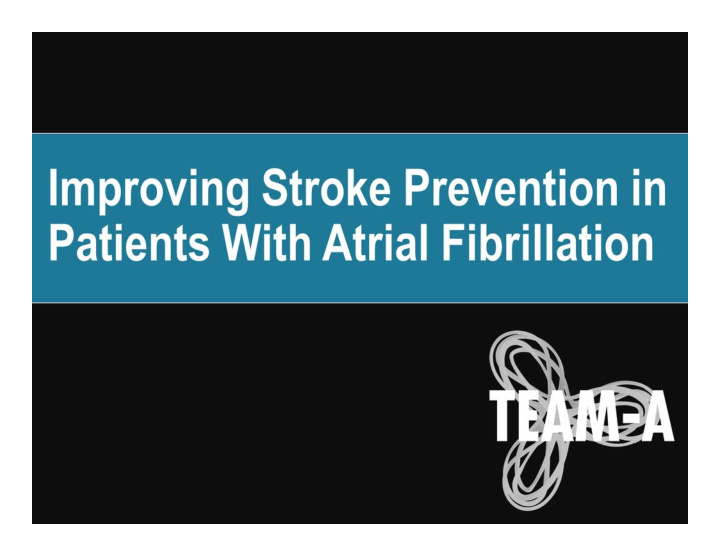



Improving Stroke Prevention in Patients With Atrial Fibrillation
Acknowledgement
Disclosures
Disclosures (cont.) • Dr. John Kylan Lynch has no disclosures • This presentation will not include any non-FDA approved or investigational uses of products or medical devices
Learning Objectives
Atrial Fibrillation (AF): Incidence and Consequences
Projected Number of Persons With AF in the US: 2000 to 2050 Atrial Fibrillation has a high public health burden
AF and Stroke
Greater Risk of Death and Recurrence With AF Strokes
Disability vs Age Group in Those With Acute Ischemic Stroke (AIS) vs AF-AIS Cardioembolic strokes are more disabling than non ‐ cardioembolic strokes
Assessing Benefits and Risks Anticoagulation:
Question
Case 1
CHADS 2 Index: A Validated Classification Scheme/Tool for Stroke Risk Based on 1733 Medicare Beneficiaries with AF who did not receive Warfarin at discharge
Weakness of CHADS 2
The CHA 2 DS 2 -VASc Index
CHA 2 DS 2 -VASc vs CHADS 2 : Which to Use?
Case 2
ACC/AHA/ESC Guidelines
Risk Stratification and Anticoagulation
Underuse of Anticoagulants in AF Systematic review of 54 studies
Barriers to Anticoagulant Use
Barriers to Anticoagulation?
Bleeding Risk
Bleeding Risk: The Reality
Anticoagulation in Patients at Risk of Falls: “Physicians’ Fears Are Often Unfounded”
Assessing Bleeding Risk: HAS-BLED
Reducing Bleeding Risk
Decision Support Anticoagulation Worksheet
Anticoagulation Decision Support Worksheet (cont.)
The Patient: Decision Making and Education
Patient vs Physician Perspectives on Anticoagulation
Explaining Risk to Patients: Numerous Tools Available
Patient Knowledge About Warfarin
Patient Adherence to Warfarin Adherence worsened than improved after Non ‐ adherent ~ 21% of time in 1 st year 6 months
Risk Factors for Warfarin Nonadherence
Improving Patient Adherence to Anticoagulants
Which Antithrombotic Therapy?
Generic/Trade Name Guide for Drugs Mentioned in Presentation
Features of Available Anticoagulants
Warfarin and Novel Anticoagulant Mechanisms of Action
Choosing an Anticoagulant
Question Check
Clopidogrel and/or Aspirin?
ACC/AHA/ESC Guidelines: Warfarin vs Aspirin
Warfarin: The Gold Standard
Currently Available Oral Anticoagulants
Clinical Trial Data
Limitations/Concerns With Available Anticoagulants
Visit TEAManticoag.com for a Medication Chart (Keyword: chart)
ACC/AHA/ESC Guidelines: Managing Through Medical Procedures to Prevent Thrombosis
Drug-Specific Guidelines for Managing Through Medical Procedures
When to Switch From Warfarin
Remain With Warfarin if …
Switching From Warfarin: How?
AHA Guidelines : Secondary Stroke Prevention AHA Recommendations (2012) ‐ Updates Indication Treatment options Stroke/TIA + AF Warfarin, dabigatran, apixiban, rivaroxaban Stroke/TIA + AF + renal failure Dabigatran (75 mg) or rivaroxaban (15 mg) (CrCL 15 ‐ 30 mL/min) Stroke/TIA + AF + renal failure Rivaroxaban, dabigatran, and apixiban NOT (CrCL <15 mL/min) recommended Stroke/TIA + AF + unable to take ASA, apixiban, ASA + Plavix may be considered anticoagulants
Visit TEAManticoag.com for Tools, Handouts, Calculators, and More
Recommend
More recommend